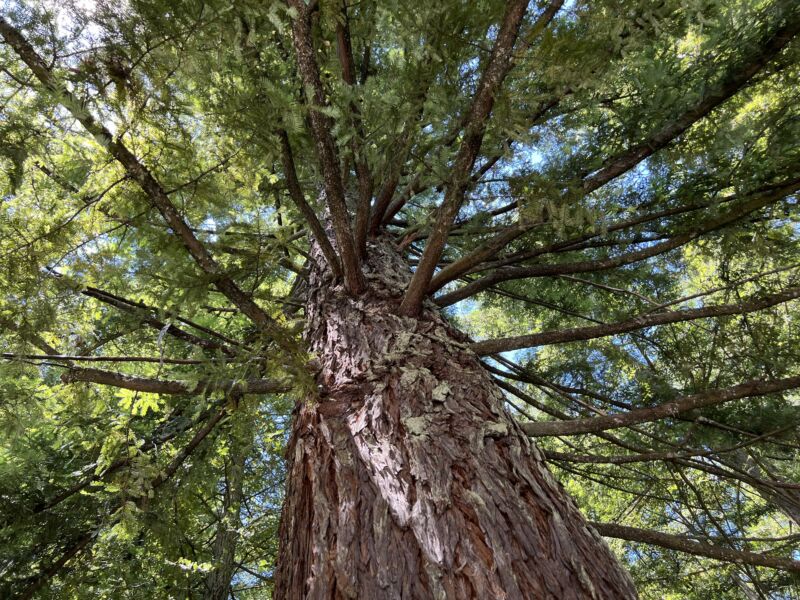
What can live for over 3,000 years, weigh over 150 tonnes and might be sitting nearly unnoticed in your local park? Large sequoias (referred to as big redwoods within the UK) are among the many tallest and heaviest organisms which have ever lived on Earth, to not point out they’ve the potential to live longer than different species.
My staff’s new study is the primary to take a look at the expansion of big sequoias within the UK—and so they appear to be doing remarkably properly. Timber at two of the three websites we studied matched the average growth rates of their counterparts within the US, the place they arrive from. These outstanding timber are being planted in an effort to assist take in carbon, however maybe extra importantly they’re turning into a placing and much-admired a part of the UK panorama.
To reside so lengthy, big sequoias have advanced to be terribly resilient. Of their native northern California, they occupy an ecological area of interest in mountainous terrain 1,400–2,100 meters above sea degree.
Their thick, spongy bark insulates in opposition to fireplace and illness, and so they can survive extreme winters and arid summers. Regardless of these challenges, these timber absorb and store CO₂ quicker and in larger portions than nearly some other on this planet, storing as much as 5 occasions extra carbon per hectare than even tropical rainforests. Nevertheless, the altering local weather means Californian big sequoias are under threat from extra frequent and excessive droughts and fires. Greater than 10 % of the remaining inhabitants of round 80,000 wild timber have been killed in a single fire in 2020 alone.
Tree giants from the US
What is way much less well-known is that there are an estimated half a million sequoias (wild and planted) in England, dotted throughout the panorama. So how properly are the UK big sequoias doing? To attempt to reply this, my staff used a method known as terrestrial laser scanning to measure the dimensions and quantity of big sequoias.
The laser sends out half one million pulses a second and if a pulse hits a tree, the 3D location of every “hit” is recorded exactly. This provides us a map of tree construction in unprecedented element, which we will use to estimate quantity and mass, successfully permitting us to estimate the tree’s weight. If we all know how outdated the timber are, we will estimate how briskly they’re rising and accumulating carbon.
As a part of a Grasp’s mission with former pupil Ross Holland, and together with colleagues at Kew Royal Botanical Gardens, we measured big sequoias throughout three websites—Benmore botanical gardens in Scotland, Kew Wakehurst in Sussex, and Havering Country Park in Essex. These websites span the wettest (Benmore) and driest (Havering) climates within the UK, enabling us to evaluate how rainfall impacts development.
The fastest-growing timber we measured are rising nearly as quick as they do in California, including 70 cm of peak and storing 160 kg of carbon per 12 months, about twice that of a native UK oak. The timber at Benmore are already among the many tallest timber within the UK at 55 meters, the present record-holder being a 66-meter Douglas Fir in Scotland. The redwoods, being quicker rising, are prone to take that title within the subsequent decade or two. And these timber are “solely” round 170 years outdated. No native tree within the UK is taller than about 47 meters. We additionally discovered important variations in development charges throughout the UK. They develop quickest within the north, the place the local weather is wetter.
So, how did these timber get right here? Exotic plant collecting was huge enterprise within the 18th and nineteenth centuries, largely as a show of wealth and style. Large sequoias have been first launched in 1853 by Scottish grain service provider and eager novice collector Patrick Matthew, who gave them to buddies. Later that very same 12 months industrial nurseryman William Lobb introduced many extra from California, together with accounts of the large timber from which they got here.
Large sequoias rapidly turned a sensation and have been planted to create imposing avenues, on the entrances of grand homes and estates, in churchyards, parks and botanic gardens. The letters about these timber helps us to precisely age planted timber, enabling us to calculate their development charges.
Usually, it is advisable take samples from a tree’s core to get an correct age estimate, however that may harm the tree.
Think about their potential
UK sequoias are unlikely to develop as tall as their Californian counterparts, which are likely to develop in forests, resulting from lightning strikes and excessive winds—at all times a danger if you’re the tallest factor within the panorama slightly than one amongst many. Extra just lately, there was a resurgence in planting big sequoias within the UK, notably in urban settings. That is due to their carbon storage potential and maybe as a result of folks appear to really like them.
We urgently want to know how UK timber will fare within the face of much hotter, drier summers, stormier winters, and with increased risks of fire. World commerce can be rising the spread of disease amongst plantlife. Extra work is required to think about the impression of planting non-native species like big sequoias on native habitats and biodiversity however our work has proven that they’re apparently very proud of our local weather to this point.
Extra importantly, now we have to do not forget that timber are extra than simply shops of carbon. If we worth timber solely as carbon sticks we are going to find yourself with hundreds of hectares of monoculture, which isn’t good for nature.
However these big sequoias are right here to remain and have gotten a fantastic and resilient a part of our panorama.
Mathias Disney, Reader in Distant Sensing, Division of Geography, UCL. This text is republished from The Conversation beneath a Artistic Commons license. Learn the original article.
